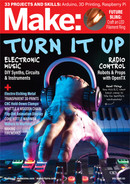
is a type of forced corrosion (Figure
F
). In the
positively charged plate, the charge excites the
electrons in the copper and zinc atoms making up
the brass, and some of these atoms give up their
outer shell electrons, to create positively charged
ions. These dissolve in the liquid electrolyte,
breaking off from the surface. Eventually, you can
start to see the build-up of copper in the solution,
as the etching process “bites” into the brass.
4. CLEAN IT UP
Before removing the sticky vinyl, I applied some
blackening solution to provide contrast to the
lettering (Figure
G
). Then I peeled away the
vinyl to reveal the final design (Figure
H
). The
blackening solution got under the sticker in a few
places, but a quick scuff with a high grit sanding
pad cleaned it up quickly.
I cut out the smaller plaques with my jeweler’s
saw and cleaned them up with my belt sander
before drilling the mounting holes (Figures
I
and
J
).
Then I used rivets to attach one to the coffee
can, my brother’s preferred vessel (Figure
K
). He
would have loved this.
To keep up with what I’m working on,
follow me @bekathwia on YouTube,
Instagram, Twitter, and at beckystern.
com.
I
J
K
99
make.co
M85_096-99_ElectroEtching_F1.indd 99M85_096-99_ElectroEtching_F1.indd 99 4/9/23 12:54 PM4/9/23 12:54 PM
..................Content has been hidden....................
You can't read the all page of ebook, please click here login for view all page.
